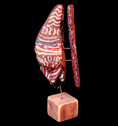
| |
River stones and their past
Marginal artists are usually painters, sculptors, draftsmen, puppets or toys
builders. They privilege manual creation.
Luigi Lineri draws and sculptures too, but seldom only. These two activities,
however are subordinated to his main work, the picking up, interpreting and
cataloguing the stones he everyday looks for on the banks of Adige river.
Playing with a terminology non pertinent to outsiders’ world we could call him a
conceptual-marginal. Conceptual because his artistic act, concentrated on a
purely intellectaul effort, is an operation of attribution of sense to found
objects; it is a question about the linguistic possibilities of objects which
are normally supposed to be non-communicant.
Marginal because he works out of consolidated schemes of art and aechaeology.
Lineri was born in 1937 in Albaro, Ronco all’Adige. Nowadays he lives with his
wife in Zevio (Verona). His research started in the sixties during some trips
with a friend interested in flint arrow points. He preferred to observe stones
and, step by step, penetrated in an unknown language that suddenly revealed
itself in the finding of the first significant stone, the sheep head. In the
70s, when his first daughter was born, he left Adige for a while. But soon
afterwards he got organized to have more time at his disposal.
His work presents itself in an incalculable series of panels hanging in order on
the walls or piled up on the floor. In every panel are sticked from two up to
eighty stones similar in shape or dimension. Panels occupy the two floors of a
building near Lineri’s house. In the courtyard quintals of stones are piled up
along the fence. His explanation is necessary for a right understanding.
According to him, stones are fruit of human intervention. It’s not possible that
shape repetition is casual. You can find them near Adige as near any other river.
The subjects he has discovered, analyzed and arranged till now are: animal heads
like sheep, fish, pig, dog, equid, bovine, male and female symbols, great
mothers, alias acephalous and pregnant silhouette, human head. There are general
characteristics on quality and quantity. Sheep is the dominant group and it’s
the most accurately realized. Pig, on the contrary, isn’t well done at all.
Human face isn’t frequent.
There are also strikers and smoothers that are tool-pebbles used by ancestors to
make sculptures thanks to the rubbing with water and sand. Heads always reveal
themselves in profile. Besides the above-mentioned ones, others result from the
fusion of two or more subjects: phallus-snouts, snout-beaks, phallus-vaginas,
striker-sculptures. The sheep head mingles with the fish since it shows at the
same time bleating and gasping act. Human face hides behind animals’.
You pass from a sort of formal resemblance to the greatest indeterminateness.
And this is what fascinates Lineri in particular. According to him, prehistoric
man created these undifferentiated shapes because they lend themselves to
various interpretations. The more they could synthesize, abstract, grasp the
essence of a subject the more they got near to real art. He calls this minimal
representative art “masking” and says: “I can see the face in so neutral and
beautiful a shape. The mask is so well done that only if you are inside language
like me you can perceive”.
The discovery of faces, snouts, hiding in every stone is given to a special
“seeing art”. You should observe the stone under a grazing light beam and move
it in order to catch on images, through the shadow mutability on their surface.
So we’ll see, for instance, a head-beak set in a sheep, contained in a great
mother. Or, turning the stone upside-down, you can see now a nose, now a beard,
now a human face disguised as a caprine animal.
In his deciphring work he often makes references to puns and dialect. Double
meanings of words like “bird” and “pig” and some exclamations such as “porco
cane” (pig dog) strike him.
Lineri, soaked in the amniotic liquid of veronese province, has been unheard for
all these years, but he never was desperate. On the contrary “the fact that
nobody believed in me nor helped me was useful to my deepening”.
He self-financed a couple of art exhibitions and the volume “Adige, a river full
of memories”, rich in photographs and explicative poems. His perseverance,
materialized in the impressive quantity of the stones, is what mostly disturbs
the sceptical observer.
Lineri has not certainly stopped at the reading of the subjects but he has
inquired into the reasons of their existence as well. According to him people
needed stones to cross the river with herds. For this reason stones were adored
and shaped as they were protagonists of rituals and magic acts. They were gifts
to water, houses fields. Everybody got them and they were everywhere. As a fruit
of an oral culture, their repetitiveness was linked to endless and progressive
rhythm of shaman songs and christian litanies. Pagan rites they were connected
with run through Catholic tradition st they can be considered ex-voto as well.
Lineri is not interested in the archaelogical-scientific method. His is a
theoretical-artistic “doing” based on a syncretism where his knowledge crosses
all his visionary and imaginative faculties. He ranges, with no difficulty, over
Jung’s and McLuhan’s work, over his personal deductions on eternal believes and
prayers, passing through reflections on dialectal word.
Lineri inquires, thanks to his fulminant intuitions, into the game mechanisms,
which all of us have done once at least in our life, of finding anthropomorphic
outlines in inanimate objects. A game which is very often part of art and
science. I still remember Ragghianti’s definition on rupestrian pictures as
“manufactured-eyefacture”, Leonardo’s spot theory, Rorschach’s test.
Anyway, even apart from his suggestive theory, undoubtedly evidence of his long
lonely research remains and it has taken shape in Lineri’s fascinating
collection, rich in ancestral echoes.
|